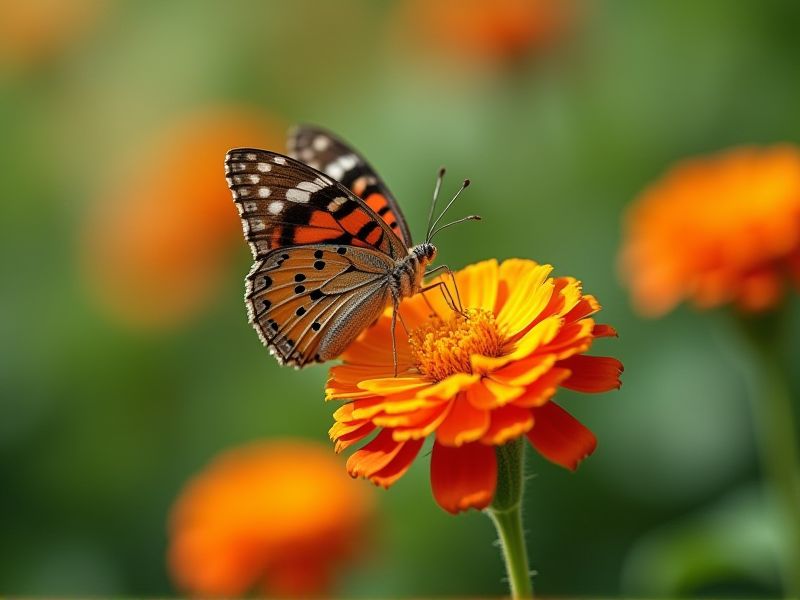
Butterfly plants, such as the milkweed (Asclepias spp.), provide essential habitats for both caterpillars and adult butterflies. These native perennials thrive in various conditions, requiring minimal maintenance once established. Consider planting lantana (Lantana camara), a drought-tolerant option that attracts numerous butterfly species with its vibrant clusters of flowers. Another excellent choice is the coneflower (Echinacea spp.), known for its resilience and ability to bloom throughout summer, supporting butterflies and beneficial pollinators. By incorporating these easy-to-care butterfly plants into your garden, you create a flourishing ecosystem that promotes biodiversity and beauty.
List of some Butterfly plants that are easy-to-care
- Butterfly Bush (Buddleja davidii)
- Lavender (Lavandula spp.)
- Coneflower (Echinacea purpurea)
- Lantana (Lantana camara)
- Milkweed (Asclepias spp.)
- Bee Balm (Monarda didyma)
- Black-eyed Susan (Rudbeckia hirta)
- Zinnia (Zinnia elegans)
- Pentas (Pentas lanceolata)
- Salvia (Salvia spp.)
Important things about Butterfly plants that are easy-to-care
Sunlight Requirements
Butterfly plants, such as milkweed and lantana, thrive best in full sun, requiring a minimum of six hours of direct sunlight daily for optimal growth. These plants attract butterflies and other pollinators, enhancing your garden's biodiversity and vibrancy. When planting, ensure your garden location receives ample sunlight, as shaded areas can hinder flowering and overall health. Proper sunlight exposure not only supports your butterfly plants' aesthetics but also fosters a lively ecosystem in your yard.
Soil Type
Butterfly plants thrive best in well-draining soil, making loamy or sandy soils ideal for promoting healthy root development. pH levels between 6.0 and 7.0 support nutrient availability, crucial for attracting butterflies to your garden. To enhance soil fertility, consider mixing organic compost or aged manure, which enriches the soil with essential nutrients. By selecting the right soil type, you can create a vibrant and welcoming environment for various butterfly species while ensuring easy maintenance of your plants.
Watering Frequency
Butterfly plants, such as milkweed and lantana, thrive in well-draining soil and typically require watering once a week. During hot summer months, you may need to increase the watering frequency to two or three times a week to keep the soil consistently moist but not soggy. Always check the top inch of soil; if it feels dry, it's time to water. Remember, over-watering can lead to root rot, so be sure to monitor your plants closely for signs of distress.
Fertilization Needs
Butterfly plants, such as milkweed and butterfly bush, thrive with minimal fertilization, making them perfect for beginner gardeners. These plants typically only require a balanced, slow-release fertilizer applied in early spring to promote healthy growth and vibrant blooms. It's essential to avoid over-fertilizing, as excessive nutrients can lead to lush foliage at the expense of flowers, which can deter butterflies. To attract more pollinators, consider planting a variety of butterfly-friendly species in your garden, ensuring a continuous source of nectar throughout the growing season.
Pest Resistance
Butterfly plants, such as milkweed and purple coneflower, are excellent choices for nurturing butterflies while demonstrating remarkable pest resistance. These plants often attract beneficial insects that help control harmful pest populations naturally, minimizing the need for chemical pesticides. By choosing native species like lantana or butterfly bush, you enhance your garden's biodiversity, providing essential nectar sources and habitat for various butterfly species. These low-maintenance plants thrive in various soil types, making them perfect for your garden while supporting local ecosystems.
Pruning Methods
Pruning butterfly plants, such as milkweed and butterfly bush, is essential for maintaining their health and promoting vibrant blooms. You should prune these perennials in early spring before new growth emerges, cutting them back to about one-third of their height to encourage bushiness and more flowers. Deadheading spent blooms during the season can also extend flowering and attract more butterflies to your garden. Proper pruning not only enhances the aesthetic appeal of your plants but also strengthens their resilience against pests and diseases.
Growth Habits
Butterfly plants, such as Buddleia and Milkweed, thrive in sunny environments and are incredibly low maintenance, making them perfect for novice gardeners. You can expect these plants to attract various butterfly species by providing a rich nectar source during the blooming season. They prefer well-drained soil and require minimal watering once established, showcasing their drought-resistant nature. Regular deadheading will promote continuous blooming, ensuring your garden remains vibrant and inviting to pollinators.
Hardiness Zones
In USDA hardiness zones 9 to 11, butterfly plants such as lantana, milkweed, and pentas thrive, offering vibrant blooms that attract pollinators. Lantana, known for its drought tolerance and continuous flowering, provides a colorful addition to any garden while supporting local butterfly species. Milkweed, essential for monarch butterflies, is low-maintenance and adapts well to various soil types, making it an ideal choice for butterfly enthusiasts. Pentas, with their star-shaped clusters, flourish in full sun and are highly attractive to butterflies, adding both beauty and ecological value to your landscape.
Companions Plants
Butterfly-friendly plants, such as milkweed and lantana, are excellent choices for creating a vibrant garden that attracts these beautiful pollinators. Milkweed, known for its unique flowers and importance to monarch butterflies, thrives in sunny spots with well-drained soil. Lantana, with its colorful blooms and ability to withstand drought, naturally draws butterflies while requiring minimal maintenance. By incorporating these easy-to-care-for companions in your garden, you can foster a thriving ecosystem that supports not only butterflies but also other beneficial insects.
Propagation Techniques
Propagating Butterfly plants, also known as Buddleja, can be easily achieved through stem cuttings, making them ideal for gardening enthusiasts who prefer low-maintenance options. To initiate the process, take cuttings from healthy plants in late spring or early summer, ensuring they are about 4-6 inches long and contain at least two leaf nodes. Dip the cut ends in rooting hormone to promote faster root development and place them in well-draining potting mix. With adequate moisture and sunlight, your cuttings should root within a few weeks, allowing you to expand your Butterfly plant collection effortlessly.
